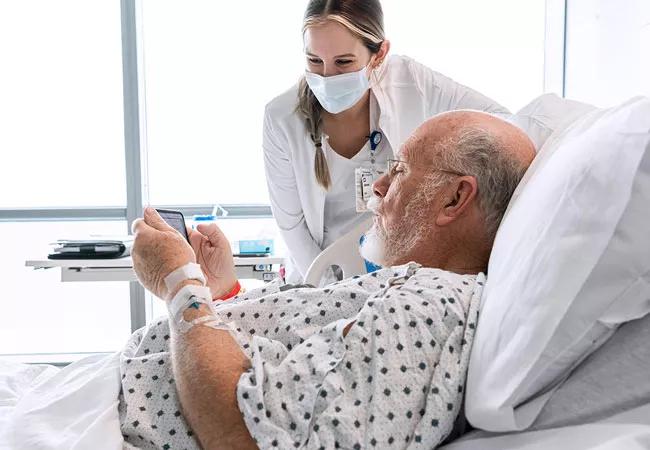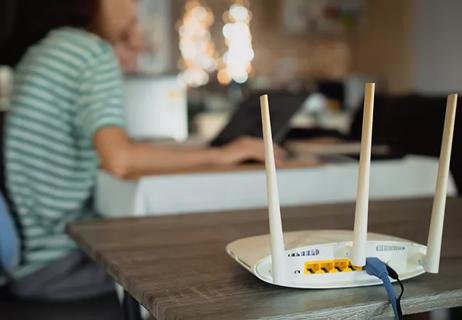Advertisement
Improving the care connection through patients' own mobile devices

A program managed by a nursing informatics team allows some Cleveland Clinic patients to use their smart phones or tablets to view their medical charts and watch educational videos pertinent to their medical condition during their hospital stay.
Advertisement
Cleveland Clinic is a non-profit academic medical center. Advertising on our site helps support our mission. We do not endorse non-Cleveland Clinic products or services. Policy
The program, called MyChart Mobile, expands patient access through MyChart, the medical web portal owned by the database company Epic. MyChart lets patients review some records and test results, schedule appointments, and communicate directly with care providers.
MyChart Mobile was introduced as a pilot project on three medical-surgical units at Cleveland Clinic main campus in 2021. Inpatients with MyChart accounts can click a button to gain access to the additional information offered while they are in the hospital. They can review prescriptions, read about their scheduled daily treatments and diagnostic tests, and see the names and photos of their care team members. The information also can be reviewed by anyone to whom the patients have granted MyChart account access.
The project’s aim is to empower people to become partners in their own care during a time when information tends to come at them quickly, says Timothy Beglin, RN, Nursing Informatics Specialist and project team leader. About 20% of patients are on the MyChart Mobile. “It is happening organically, because adults who are actively involved with their MyChart accounts find the program.”
The mobile program represents an expansion of MyChart Bedside, which for several years has allowed inpatients on a limited number of units to use hospital-owned devices to review more chart information.
“MyChart Mobile removes the requirement for a hospital device,” Beglin says. “Now hospitalized patients can connect to MyChart Mobile as easily as they do their MyChart account. The system automatically recognizes that a patient has been admitted and invites them to access their chart information. They just hit a button. It’s seamless.”
MyChart Mobile makes it easier for patients to process and retain information important to their stay and, ultimately, to their health after they leave. A secondary aim of the initial three-month MyChart Mobile pilot was to test whether the benefits of offering the service are worth its costs. Cleveland Clinic covers the cost of offering MyChart access to patients; the additional access offered through MyChart Mobile incurs another fee, which the health system also pays.
“We track how many patients are getting into MyChart Mobile and how many times they are coming back,” Beglin says. “We’ve seen patients returning between 40 and 60 times per hospital stay. Receiving around 50 touches per patient user during one inpatient stay tells us that the program is meaningful to users.”
The informatics team also tracks whether the mobile access spurs previously unconnected patients to open a MyChart account. “We’re hoping to increase the total number of MyChart activations,” Beglin says. “Overall, we haven’t seen a huge increase yet.”
Advertisement
The demands of the COVID-19 pandemic slowed expansion of MyChart Mobile, but Beglin says the next steps will be to consider which units would most benefit from offering the service.
“All of our units have patients who might benefit, but some patients have more learning to do than others,” Beglin says. “For instance, on a neonatal intensive care unit, you have young couples who often have a strong desire to know more. In obstetrics, patients are undergoing new procedures they may want to understand better. There are many different ways we can proceed with expansion, and many providers are very enthusiastic about the possibilities.”
Building the library of educational videos is among this year’s goals. Beglin notes that the videos themselves are well made, relying on contemporary techniques that incorporate medical animation and illustration along with information delivered by medical experts. Some of the videos contain general information for patients, and some are specific to cardiology, neurology and gastrointestinal conditions.
“The videos are automatically assigned to patients through MyChart based upon the patient’s status and nursing documentation,” Beglin says. “We currently have about 25, but we know that’s just the tip of the iceberg. Videos serve as educational support, along with education delivered by nurses to patients and their family members.”
The pressing demands of COVID-19 slowed some of the progress the team hoped to make with expansion of MyChart Mobile, but they expect that to change soon.
“We think 2022 is going to be a chance to really expand this program,” Beglin says. “We love what we’re seeing on the three pilot units, and we’re just scratching the surface on some of this.”
Advertisement
Advertisement

A centralized electronic tool improved clinical oversight and operational efficiency

Cleveland Clinic’s roadmap to recovering critical digital assets stems from strategic planning and preparedness

The Friends of Cybersecurity program bridges innovative technology solutions with mitigating security risks

Cleveland Clinic’s Information Technology Apprenticeship Program expands skill set while leading to meaningful employment

Protecting patient data and privacy while preventing unnecessary risks

While logistical questions remain about RPM, its benefits for both patients and caregivers are abundantly clear

Telehealth aids in treatment of fibromyalgia and median arcuate ligament syndrome

Rates of CR eligibility high and internet access low among older patients in rural areas